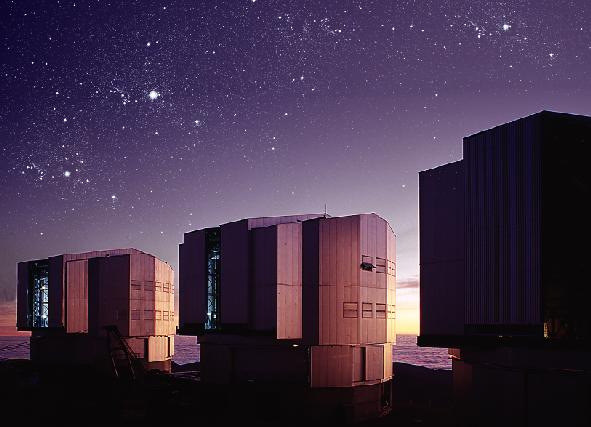ASTR 1210 (O'Connell) Study Guide
1. INTRODUCTION: SCIENTIFIC DISCOVERY
AND THE SCALE OF THE UNIVERSE

The European Southern Observatory Very Large Telescope, Chile.
A. What is Science?
My definition
-
Science is the systematic understanding of empirical
phenomena.
"Empirical" = experienced or observed
Science is both a body of knowledge and a way of thinking.
Scientific values & methods are relatively new in human
history, starting ca. 1500 AD.
Characteristics
- Logical; rational
- Clear, orderly; choose the simplest alternative ("Occam's razor")
- Cumulative development
-
New interpretations are required to be consistent with all
established facts.
Given all that we now know about nature, this is a tremendously challenging requirement!
Key feature
- Science is based on an empirical criterion
of truth: ideas are tested by objective experiment/observation in
the real world.
- Evaluation of evidence must be rigorous, objective, and public.
- Any valid scientific proposition is falsifiable by empirical tests. I.e. it is well enough defined that you can specify in advance those outcomes that would show the idea to be wrong.
- The results of tests must be repeatable.
- Confidence in ideas grows with the number of independent tests or validations. "Independence" implies verification not only by different people but also by different methods of inquiry or lines of evidence.
The scientific method in practice
-
Scientific methods were not invented or prescribed wholesale by
some individual or group. Rather, they emerged over a period of several
centuries as the set of analytical techniques that proved most
successful in the struggle to understand nature.
The usual formalized statement of "The Scientific Method"
(Hypothesis ===> Prediction ===> Experiment ===> Interpretation
===> Repeat) is misleading:
-
Scientists do not necessarily work from "hypotheses." They frequently
simply explore the characteristics of new phenomena, without
any particular intent to distinguish between interpretations but with
the hope that they might prove interesting or important.
A number of sciences, including astronomy, deal with phenomena that
cannot be manipulated by humans. Experiments are impossible in
these cases. These sciences must rely instead on passive
observations.
-
For astronomy, the only exception is that we can,
with difficulty, sample and experiment with the surfaces and
atmospheres of some of the other bodies in the solar system.
Science and "Truth"
- Scientific ideas are not claimed to be absolute
truths. They are always provisional, to a greater or lesser
degree. They are regarded as approximations to the truth,
subject to revision as new evidence emerges. They systematically
improve with time, by discarding older, less successful
interpretations.
On the other hand, scientific conclusions have a much larger
edifice of validated evidence behind them than alternatives based on
non-scientific standards of truth (e.g. personal experience or
popular anecdotes).
Science and "Common Sense"
-
The characteristics of scientific thinking should sound familiar to
you: this is really nothing more than slightly refined, standardized,
and tough-minded "common sense." Scientific thinking deviates
from "common sense" mainly in that it insists on validating ideas in
the context of a vast store of existing knowledge that goes
far beyond everyday experience.
 The subjects and conclusions of science, however, often
differ drastically from the "common-sense perspective"
that we intuitively develop in our everyday lives. The familiar
structures that surround us (e.g. trees, rivers, mountains) are
utterly different from those that characterize spatial scales only a
couple of orders of magnitude (i.e. a couple of factors of ten)
removed, either larger or smaller. And nature comprises an almost
unimaginable range of physical scales, as illustrated at the
right.
Humans directly experience only a minuscule range of the
distances, timescales, masses, densities, velocities, and energy
releases that prevail in the universe around us, and those are
often completely non-intuitive for us.
In fact, most of science deals with phenomena that
are "invisible" in everyday life even if they, like electrons
and bacteria, are actually ubiquitous in the world around us. They
have been recognized by scientists only gradually through systematic,
painstaking observations, experiments, and measurements.
The subjects and conclusions of science, however, often
differ drastically from the "common-sense perspective"
that we intuitively develop in our everyday lives. The familiar
structures that surround us (e.g. trees, rivers, mountains) are
utterly different from those that characterize spatial scales only a
couple of orders of magnitude (i.e. a couple of factors of ten)
removed, either larger or smaller. And nature comprises an almost
unimaginable range of physical scales, as illustrated at the
right.
Humans directly experience only a minuscule range of the
distances, timescales, masses, densities, velocities, and energy
releases that prevail in the universe around us, and those are
often completely non-intuitive for us.
In fact, most of science deals with phenomena that
are "invisible" in everyday life even if they, like electrons
and bacteria, are actually ubiquitous in the world around us. They
have been recognized by scientists only gradually through systematic,
painstaking observations, experiments, and measurements.
- One of the difficulties in
communicating science to others is leading the audience to
appreciate this real but invisible landscape.
Science and mathematics
-
Mathematics is integral to science. In most physical sciences,
including astronomy, mathematics is an essential technical ingredient
in interpretation. Large swaths of modern biology and medical
science, based on interpretation of the structures of huge nucleic
acid and protein molecules, are likewise highly quantitative.
Mathematics is needed in the design and analysis of experiments. For
example, it is used to determine how the inevitable uncertainty in any
measurement affects the reliability of scientific inferences,
especially since these often depend on combining measurements of
dozens of different quantities, each with its own limitations. But
even where complicated mathematics is not required, the rules of
logic, as elaborated by mathematics, are still essential to science.
It is actually surprising that mathematics, developed for the most
part in the abstract, is capable of describing the real, empirical
universe with exquisite accuracy. This mysterious "unreasonable
effectiveness" of mathematics has been the subject of
a number of thoughtful studies.
The symbiosis between science and mathematics is evident even in the
historical context. The first society to develop a scientific outlook
was ancient Greece (ca. 300 BC), whose
thinkers were simultaneously laying the foundations of mathematics.
And
Galileo, the Italian scientist
whose 17th century experiments were the breakthrough that ignited
modern physics, believed that without mathematics "we are wandering in
vain through a dark labyrinth" --- i.e. that the clarifying insights
of mathematics are essential to understanding the universe.
And, needless to say, the algorithms behind all the computerized
applications that seem to run our world today are mathematical.
"Artificial Intelligence" is applied mathematics on a grand scale.
B. Alternative Modes of Thought
It is worthwhile distinguishing science from some other important modes of thinking.Revelation (religion)
-
Explanations are sought by appeal to a spiritual realm beyond the
natural world ("super"-natural).
Prior to the development of science, important physical phenomena were
usually interpreted as the product of deliberate and purposeful
manipulation by supernatural agencies, with motives largely beyond
human understanding. Knowledge of these agencies was thought to be
possible only through intentional revelation by them.
By contrast, science deals only with the natural world.
It seeks explanations of natural phenomena in terms of other natural
phenomena.
Supernatural explanations are not acceptable to scientists because
there is no way to test them.
-
Objective empirical tests are impossible for the supernatural world.
Science cannot predict supernatural behavior or its
intervention in our world since, by definition, the laws of nature
don't apply.
However, science could in principle detect supernatural
intervention in the natural world a posteriori (after the
fact) because it would appear as a breakdown in the laws of nature.
The fact that discontinuities in natural law have never been verified
shows that direct intervention is rare at current levels of
detection. Frequent intervention would produce an arbitrary and
largely unintelligible world.
Idealism
-
Idealism gives priority to the human mind and its constructs
over evidence from the external world. It asserts that truthful
conclusions about the natural world can be reached purely by analysis
of ideas.
Idealism was first championed by ancient Greek philosophers, most
famously Plato.
Deductions about the physical world are made from abstract, a
priori postulates. It is assumed that empirical evidence
is corrupted and unreliable.
While this approach may be fine for mathematics (in which the Greeks
excelled), it is badly flawed as a means of assessing the real
world.
Authority
-
Ideas are tested by appeal to the pronouncements of an individual or
small group. These cannot be questioned or superseded. Again,
a non-democratic system.
- The most familiar, and dangerous, variety of authoritative
"truth" is found in dictatorships. But authority is also the basis of
the case law system ("precedent") in American jurisprudence.
Social systems based on revelation almost always invoke authority
as well.
-
Scientific "authorities" are respected not because of
who they are but instead because of what they say.
Their ideas are continuously subjected to new tests. The best idea
prevails.
Young scientists often aspire to overthrow "authorities" like
Einstein; they almost always fail because their ideas are
not as good when tested against the evidence.
Pseudo-science
-
"Pseudo-scientific" investigations fall at the margins of science.
They are often devoted to topics of some popular interest -- such as
astrology
or "unidentified flying objects" (UFOs) in
the case of astronomy -- but which have either not yet been validated
by mainstream science or have been rejected by it.
Advocates of pseudo-scientific investigations apply some, but not
all, of the established methods of science. These fall
short of the basic criteria listed above in important ways. They
always involve a lack of adequate evidence and frequently
contradict validated principles of science. But they have credibility
for many people because they resemble science, and this opens a
large arena for human folly.
We will discuss pseudo-science further, and the "UFO phenomenon" as an
example, later in Study Guide 18.
C. Skepticism
"Cultivated skepticism" is a cornerstone of science. All good scientists are skeptics. This means that they maintain an attitude of doubt or of suspended judgement about scientific ideas.
-
Scientists insist on the best possible evidence in support of
new ideas. The adjective that best describes the scientific approach
to evidence is "relentless."
Accepted ideas, no matter how well established, are constantly
tested against new evidence, sifted for quality. All
preconceptions are subject to scrutiny. History shows that truth only
emerges through this kind of skeptical "scrubbing" of ideas and
evidence. The ideas that survive this process are very robust.
Competition over ideas, often intense, is a hallmark of science in
practice. There are strong incentives for scientists to discover new
phenomena or interpretations that countervail the accepted wisdom.
That is how young people make careers in science.
However, scientific doubt isn't frivolous; it must be based on a
balanced evaluation of the quality of the empirical evidence.
Good scientists are scrupulous in their treatment (positive or
negative) of the evidence; their reputations suffer otherwise.
Don't confuse healthy scientific skepticism with the activist
"skeptics" who have emerged over the last couple of decades to
dispute the scientific consensus on evolution, global warming,
vaccination against disease, tobacco-induced illness, and other
politically or religiously sensitive subjects. These advocacy groups
mostly do not care about the quality of the evidence or hold their
judgement in suspension -- rather they have a committed belief in a
contrary view or a financial stake in opposing the consensus.
This kind of agenda-driven "skepticism" is now sometimes called
denialism.
-
As Bertrand
Russell remarked, and as we can see daily in news reports
(especially about politics), this may be the
"fundamental cause of trouble in the world
today."
"He believed in the primacy of doubt, not as
a blemish upon our ability to know
but as the essence of
knowing."
---- J. Gleick, writing about physicist Richard Feynman.

The Golden Gate Bridge, a premier example
of 20th century
technology
D. Science vs. Technology
Although science and modern technology are often intertwined, they have different goals and value systems; and we need to clarify the distinctions between them. Science and technology are symbiotic but distinct:- Science: The attempt to understand nature; to build
a conceptual framework.
-
Adjectives used: "unapplied," "pure" or "basic"
Examples: principles of gravitation, electromagnetism, biochemistry,
astronomy
- Technology: Application of basic concepts to
societal needs.
-
Examples: structural engineering, electrical generators, weapons,
pharmacology, computers
- Scientist: "be curious"
- Technologist: "be useful"

E. Results of Science
The basic result of science
-
Nature is understandable and operates
according to a small set of universal principles, or "laws"
We may take this for granted today, but it is an astonishing fact.
None of the early scientists who wrestled with trying to interpret
nature could have predicted it. The notion that a rainbow, lightning,
and the shape of a snowflake are all governed by exactly the same
underlying principles would have sounded absurd to them.
Some other key results
- The laws of nature are the same everywhere in the observed universe
- All matter, including living systems, is organized hierarchically from
a smaller set of subunits
- The structure of molecules & atoms is determined by electromagnetic force
- The Sun is a star
- The Earth is a planet
- Genetic information is transmitted to new generations by DNA molecules
- Most communicable diseases are caused by microorganisms
- The universe is very ancient but had a definite beginning
about 14 billion years ago.
Its structure and contents have changed systematically
with time
Precursors
-
Very few of the important results of science had recognizable
precedents in modes of thought prior to 1500 AD.
The main exceptions are Greek physics and astronomy, e.g. the
models of the solar system by Ptolemy, ca. 130 AD, or the atomic
theory of Democritus, ca. 420 BC. The Greeks made great progress.
However, because of their inclination to idealism, they disdained
empirical testing of scientific ideas, which circumscribed their
ultimate accomplishments. And those were forgotten or actively
suppressed in the Western world for nearly a thousand years starting
about 400 AD. See Study Guide 6.
How well determined are scientific results?
-
Some scientific results are known with effective certainty
(e.g. Earth is a planet; only one Sun in the solar system).
-
Aside from reaching reliable conclusions, scientists have been able
to measure many important aspects of nature with amazing
precision. Even in astronomy, where we cannot exert control over the
things we are measuring, a number of quantities -- e.g. the distance
between the Earth and the Sun -- have been determined to a precision
of better than one part in ten billion.
 But, as noted above, scientific results are subject to revision
based on new evidence. Scientific ideas normally systematically
improve by discarding older, less successful interpretations.
But, as noted above, scientific results are subject to revision
based on new evidence. Scientific ideas normally systematically
improve by discarding older, less successful interpretations.
-
You can picture the progress of science as an inward spiral toward
the truth as better evidence accumulates.
-
Among science that is less well established are many "interesting"
results in areas like human psychology and the influence
of lifestyle on health (especially diet). Unfortunately, these
tend to get wide publicity (isn't it great to hear that chocolate is
good for your heart?). And when contrary studies appear later, this
diminishes confidence in science overall.
-
Difficulties in these areas arise because it isn't ethical to
experiment on human subjects in ways that might produce more
definitive conclusions. Large samples are often hard to gather, but
small samples yield large experimental scatter and also prevent
assessment of the effects of the huge range of personal
characteristics. And in the absence of hard statistics, investigators
are sometimes swayed by random variations in ambiguous data sets that
seem to confirm their hypotheses and are reluctant to publish studies
that contradict those. You shouldn't judge the reliability of basic
scientific conclusions by the muddled impression emerging from
popular media.
-
If our scientific understanding of nature was seriously flawed, then
most of our technology would simply not work. The validity of
ideas like Newton's laws of motion or Maxwell's theory of
electromagnetism or the germ theory of disease is tested
continuously in every automobile, cell phone, and hospital in the
world.
Keep this success in mind when evaluating debates over scientific
results in the public arena. The same analytic procedures and
standards of evidence that produced the technologies we absolutely
depend on in our daily lives are behind the scientific consensus in
areas like biological evolution, the value of vaccines, or global
warming that are disputed by activist groups.
Influence on society
-
As a new mode of thinking about the natural world, science succeeded
brilliantly. It demonstrated that humans can solve many problems
that at first seemed intractable: e.g. questions like "what causes
bubonic plague?" or "what are the stars?"
or "how old is the Earth?"
- Success in science has been a great source of optimism
in human cultures. This was a major wellspring for the Enlightenment
and the political philosophies that culminated in the founding of
Western democracy.

The Moon and Venus at dusk
F. Astronomy as a Science
Astronomy is the study of the physical universe beyond the Earth's atmosphere. It is the oldest science, nearly universally practiced in literate and pre-literate societies, and it has been a major stimulus to other scientific fields from Greek times to modern physicsRelevance to society
- Astronomy investigates ultimate origins (an adjunct or alternative to religion)
- Astronomy provides our basic global perspective of time and
space, i.e. a cosmic context
- Astronomy was fundamental to the historical development of
scientific thinking and the formulation of the first generalized
physical laws by Newton.
- Study of the other planets and our cosmic environment is essential to assessing the viability of Earth's biosphere and prospects for long-term human survival.
History of societal influence
- All societies: practical time- and calendar-keeping, navigation
- 5000 BC - 1609 AD: awareness of the Solar System (planets, sun)
- 16th-17th centuries: astronomy leads in the demolishment of medieval thinking
- 1609: the newly-invented telescope reveals a vast stellar system beyond the planets, enormously expanding the horizon of human thought
- Late 1600's: astronomy leads Newton to his laws of motion, which initiate the "scientific revolution" and modern technology
- 19th century: speculation about extraterrestrial life
- 20th century: recognition of galaxies ("island universes"), the expanding & evolving universe, the Big Bang, exploration of the Moon and planets by the space program, the extraterrestrial cause of mass biological extinctions; discovery of other solar systems.

Starfield near the center of the Milky Way. How many
stars can you count here?
Click for a full-resolution
enlargement. (Image from the Hubble Space
Telescope.)
G. ASTRONOMICAL DISTANCES AND AGES
Astronomical time- and distance-scales are tremendously larger than the "common sense" scales we encounter in everyday life. See the chart above for scales of 107 meters and above. Unfortunately, this means that astronomical scales (not to mention atomic or molecular scales) are utterly non-intuitive for us. It is important for astronomers to develop a good cosmic perspective that transcends the perceptual biases of everyday experience. But it is difficult for anyone to visualize the scales involved. Because the cosmic range is so enormous, scientists make regular use of scientific mathematical notation ("powers of ten"). For a review of this notation, see Supplement I (PDF file).Example astronomical scale models
-
Simple scale models can provide a rough, if never completely adequate,
impression of cosmic scales:
- As an example of the contrast between human perceptions and
physical reality consider the Earth's atmosphere. It seems
enormous and all-encompassing, right? Atmospheric disturbances
(rainstorms, tornados, hurricanes, droughts) easily destroy human
structures and livelihoods.
-
Can you propose a simple scale model for the atmosphere, using,
for example, a basketball to represent the Earth?
Click here for the answer.
Despite our impression, the atmosphere represents only a tiny fraction
(one part in 1600) of the Earth's diameter.
See this image taken
from a spacecraft, showing the atmosphere as a thin blue line on the
horizon. (The dark ridge of snow-capped mountains running diagonally
across the Earth's surface is the Himalayas, the world's highest.)
In fact, you can actually walk out of Earth's atmosphere.
Anyone who has been above 26,000 feet altitude (and there are 14
mountains this high) has been beyond the point where the air density
has dropped a factor of 2.7---the official
"one scale
height" definition of the atmosphere's thickness.
- A sample cosmic time scale:
- The age of the Sun is about 5 billion years, a middling
age for an older star. Suppose we wanted to use the run of all
the letters in our textbook to represent this span of time.
How many years would we have to assign to each letter?
-
We discussed this in the introductory lecture, and by
"rough order of magnitude
estimation" we determined that there would be about 2000
years per letter(!) if the entire textbook represented the age of
the Sun.
All of recorded human history would fit within the first four
letters of the text! The existence of Homo sapiens on
Earth would extend only a couple of sentences! (Modern humans have
existed only for about 200,000 years, or 0.004% of the age of the
Sun.)
Here is an image of the
first two pages of our textbook with the beginning of this
time-scale model superposed.
The Earth is almost the same age as the Sun, so our scale model
graphically illustrates the vast span of time over which the surface,
atmosphere, and biosphere of our planet have been shaped into their
present form.
Your first homework assignment was simply to stare at
random pages from the textbook and try to absorb, in the context of
this scale model, the nearly unimaginable period over which the Earth
has evolved.
- The "dripping faucet effect": the very long time scales that characterize planetary evolution mean that small but persistent changes can eventually have major consequences. We will see many examples of these (e.g. polar precession, continental drift, biological evolution).
- The age of the Sun is about 5 billion years, a middling
age for an older star. Suppose we wanted to use the run of all
the letters in our textbook to represent this span of time.
How many years would we have to assign to each letter?
- Finally, a healthy, fruit-based cosmic distance scale model:
- Use an orange to represent the Sun. This is an
appropriate choice not just because of the color but also because the mean
mass density of the Sun is about the same as an orange (1
gram/cc).
-
In this model, the Earth to Sun distance (defined to be one
"Astronomical Unit") is 25 ft.
[Useful mnemonic: Earth diam : Sun diam : Astron Unit = 1:100:10,000]
- In this model, what is the scale distance to the next nearest
star (Alpha Centauri)?
- An additional relevant piece of information that might help
you think about this question is that the Sun is about 10 billion times
brighter than the brightest stars as seen from Earth and that most
of this difference is a distance effect.
- Here's the surprising answer. It illustrates how incredibly thinly matter is spread on a cosmic scale by the standards of our everyday, "common-sense" world.
- Use an orange to represent the Sun. This is an
appropriate choice not just because of the color but also because the mean
mass density of the Sun is about the same as an orange (1
gram/cc).
Reading for this lecture:
-
Bennett textbook: Ch 1 and Secs 3.4, 3.5.
Study Guide 1
Optional reading: Alan Cromer: Uncommon Sense; Bertrand Russell:
A History of Western Philosophy; Carl Sagan: The Demon Haunted
World
-
Bennett textbook: Ch 1 and Secs 3.4, 3.5.
Study Guide 2
Supplement I (PDF file) Skim and then refer to
this later as needed.
Optional: Cosmic History: A
Brief Narrative
Optional: browse the material on the structure &
evolution of the universe in the Bennett textbook Chs
22 and 23
-
Slides
shown in lecture (pptx)
History of Science from Encyclopedia Britannica
- Note: you must be logged on through UVa to access Britannica
Internet Encyclopedia of Philosophy
Field Guide to Critical Thinking (from Skeptical Inquirer Magazine)
Bad Astronomy (a site devoted to debunking astronomical misconceptions, fraud, and pseudoscience, run by UVa Astronomy grad Phil Plait)
Simanek's Pseudo Science & Related Links TEDx Talk on Skepticism (nice 24-minute tour of faith, denialism, and the value of skeptical thinking in our lives by George Hrab) Correspondence with a student on the practice of science (O'Connell) More on the scale of the universe & powers of ten (Study Guide 2)
Science, Technology, and Society (Study Guide 9)
Size of our biosphere (Study Guide 12)
More discussion of UFO's & pseudoscience (Study Guide 18)
 Guide Index
Guide Index
|
 Next Guide
Next Guide
|